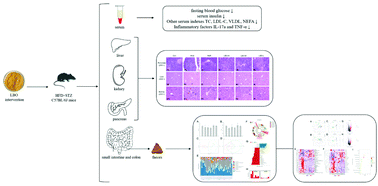Oligosaccharides derived from Lycium barbarum ameliorate glycolipid metabolism and modulate the gut microbiota community and the faecal metabolites in a type 2 diabetes mouse model: metabolomic bioinformatic analysis†
Abstract
Herein, we assessed the effects of Lycium barbarum oligosaccharides (LBO) on the intestinal microenvironment of a type 2 diabetes (T2D) mouse model through gut microbiome and metabolomics analysis. We set high (300 mg kg−1), medium (200 mg kg−1), and low (100 mg kg−1) doses of LBO for intervention once a day for 4 weeks. The results showed that the intervention effect of the medium-dose group was the most significant. It reduced the symptoms of hyperglycemia, inflammation, insulin resistance, and lipid accumulation in the T2D mouse model. It restored the structure of damaged tissues and cells, such as the pancreas, liver, and kidneys. LBO increased the relative abundance of beneficial bacteria, such as Lactobacillus, Bacteroides, Prevotella, and Akkermansia, and maintained intestinal barrier integrity. The faecal metabolic map showed that the contents of glycogen amino acids, such as proline, serine, and leucine, increased. The contents of cholic, capric, and dodecanoic acid decreased. In summary, we may suggest that LBO can be used as a prebiotic for treating T2D.



 Please wait while we load your content...
Please wait while we load your content...